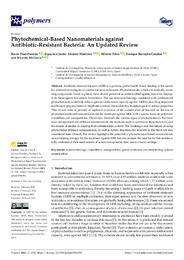Por favor, use este identificador para citar o enlazar este ítem:
https://hdl.handle.net/11000/30504Registro completo de metadatos
| Campo DC | Valor | Lengua/Idioma |
|---|---|---|
| dc.contributor.author | Diaz-Puertas, Rocio | - |
| dc.contributor.author | Álvarez-Martínez, Francisco Javier | - |
| dc.contributor.author | Barrajón-Catalán, Enrique | - |
| dc.contributor.other | Departamentos de la UMH::Ingeniería | es_ES |
| dc.date.accessioned | 2024-01-12T08:11:39Z | - |
| dc.date.available | 2024-01-12T08:11:39Z | - |
| dc.date.created | 2023-03 | - |
| dc.identifier.citation | Polymers 2023, 15(6) | es_ES |
| dc.identifier.issn | 2073-4360 | - |
| dc.identifier.uri | https://hdl.handle.net/11000/30504 | - |
| dc.description.abstract | Antibiotic-resistant bacteria (ARB) is a growing global health threat, leading to the search for alternative strategies to combat bacterial infections. Phytochemicals, which are naturally occurring compounds found in plants, have shown potential as antimicrobial agents; however, therapy with these agents has certain limitations. The use of nanotechnology combined with antibacterial phytochemicals could help achieve greater antibacterial capacity against ARB by providing improved mechanical, physicochemical, biopharmaceutical, bioavailability, morphological or release properties. This review aims to provide an updated overview of the current state of research on the use of phytochemical-based nanomaterials for the treatment against ARB, with a special focus on polymeric nanofibers and nanoparticles. The review discusses the various types of phytochemicals that have been incorporated into different nanomaterials, the methods used to synthesize these materials, and the results of studies evaluating their antimicrobial activity. The challenges and limitations of using phytochemical-based nanomaterials, as well as future directions for research in this field, are also considered here. Overall, this review highlights the potential of phytochemical-based nanomaterials as a promising strategy for the treatment against ARB, but also stresses the need for further studies to fully understand their mechanisms of action and optimize their use in clinical settings | es_ES |
| dc.format | application/pdf | es_ES |
| dc.format.extent | 22 | es_ES |
| dc.language.iso | eng | es_ES |
| dc.publisher | MDPI | es_ES |
| dc.rights | info:eu-repo/semantics/openAccess | es_ES |
| dc.rights.uri | http://creativecommons.org/licenses/by-nc-nd/4.0/ | * |
| dc.subject | nanotechnology | es_ES |
| dc.subject | nanofibers | es_ES |
| dc.subject | nanoparticles | es_ES |
| dc.subject | green synthesis | es_ES |
| dc.subject | electrospinning | es_ES |
| dc.subject | plants | es_ES |
| dc.subject | antimicrobial | es_ES |
| dc.subject.other | CDU::6 - Ciencias aplicadas::62 - Ingeniería. Tecnología | es_ES |
| dc.title | Phytochemical-Based Nanomaterials against Antibiotic-Resistant Bacteria: An Updated Review | es_ES |
| dc.type | info:eu-repo/semantics/article | es_ES |
| dc.relation.publisherversion | https://doi.org/10.3390/polym15061392 | es_ES |

Ver/Abrir:
polymers-15-01392.pdf
1,9 MB
Adobe PDF
Compartir:
 La licencia se describe como: Atribución-NonComercial-NoDerivada 4.0 Internacional.
La licencia se describe como: Atribución-NonComercial-NoDerivada 4.0 Internacional.
.png)